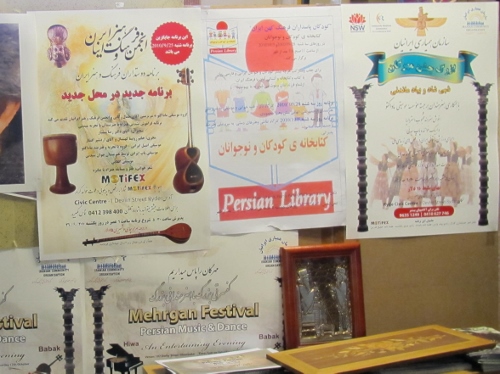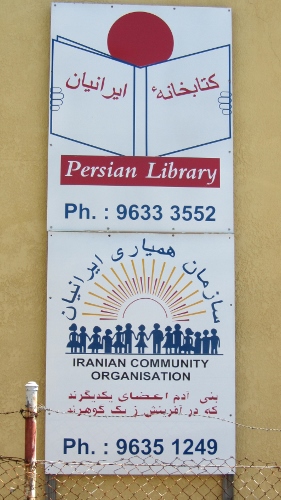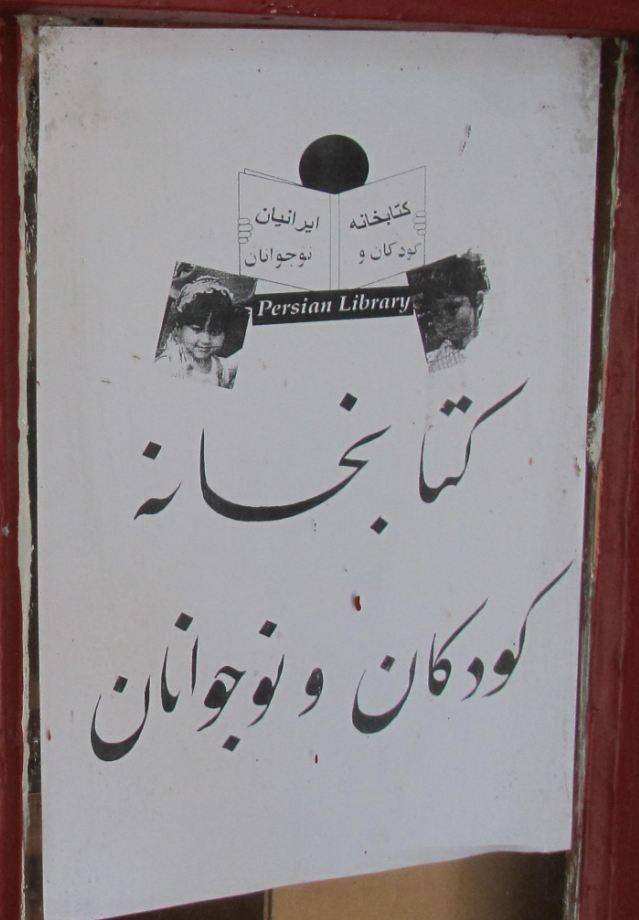Clik here to view.

Fliers for Persian community events (Persian Library Parramatta, Nov 2010)
Editor’s note: In the second instalment in our series “Explorations in Language Shaming”, Dr Shiva Motaghi-Tabari examines children’s attitudes towards the perception of home languages other than English in Australia highlighting that home-language use may often be associated with a sense of embarrassment.
***
Home-language (HL) maintenance as a concern for many migrant families has recently gained prominence. Much of the research has focused mainly on the role of parents and HL educators in child HL learning processes, while the role of children in this effect remained almost invisible. In my doctoral research on “Bidirectional Language Learning in Migrant Families”, I demonstrated that children’s language attitudes, which in turn are influenced by language ideologies and wider social structures, can have significant impacts on their HL maintenance.
In fact, the broad impetus for my research germinated from my own observation of my child’s language learning and use, and my engagements with other parents in a similar situation since we came to Australia in 2008. Like many migrant parents coming from a non-English-speaking background, maintaining my child’s HL has been a concern in our new home in Australia. When we first came, my daughter was around seven years old. At the time, she knew some English, as we had sent her to language schools since she was four years old back in Iran. After arrival, I observed how quickly her English language, particularly her conversational skills, were progressing. As her English language progressed, I began to wonder if it might not be a good idea to use some English at home. After all, her father and I also needed to improve our English communication skills …
At the same time, we did not wish to put our daughter’s Persian at risk. Her Persian maintenance was not only important to us, but it was also a promise to her grandparents who relentlessly reminded us of the importance of preserving their grandchild’s Persian language. For this very reason, we also sent her to a Persian Saturday School in Sydney so that she would become literate in the language.
Image may be NSFW.
Clik here to view. In our search for effective ways of managing the two languages, Persian and English, we heard many parents’ stories of success or failure related to their HL maintenance. For some of the parents, despite their investments of time and money, they found it challenging to get their children to learn and use their HL. Some of them blamed the Community Language School teachers for not being able to teach the HL properly, and some of them blamed themselves for not spending enough time to practice the language with their children. Some of them also seemed confused as they had been advised by their children’s mainstream teachers to speak English with their children.
In our search for effective ways of managing the two languages, Persian and English, we heard many parents’ stories of success or failure related to their HL maintenance. For some of the parents, despite their investments of time and money, they found it challenging to get their children to learn and use their HL. Some of them blamed the Community Language School teachers for not being able to teach the HL properly, and some of them blamed themselves for not spending enough time to practice the language with their children. Some of them also seemed confused as they had been advised by their children’s mainstream teachers to speak English with their children.
Eventually, these observations shaped my interest in doing further research in the area, and that’s how my PhD research ‘Bidirectional Language Learning in Migrant Families’ came into existence. That my research struck a chord is obvious from the fact that it won the 2017 Michael Clyne Prize. The Michael Clyne Prize is awarded annually by the Australian Linguistics Society for the best postgraduate research thesis in immigrant bilingualism and language contact.
‘Bidirectionality’ in parent-child interactions is a notion that I have borrowed from family studies and extended to the field of second language learning. In a bidirectional model, the process of socialisation of a child into a set of language and cultural rules involves not only a parent-to-child direction of influence but also a child-to-parent direction. Central to the bidirectional model is the concept of agency. Agency in this framework means “considering individuals as actors with the ability to make sense of the environment, initiate change, and make choices” (Kuczynski, 2003, p. 9). The core assumption in this framework is that both parents and children as active agents interpret and thereby reconstruct social messages (Kuczynski, Parkin, & Pitman, 2014, p. 138). This means that, in the field of language learning, children, like adults, adopt a certain way of thinking about languages based on the language ideologies they encounter in their daily lives. Based on these social perceptions, they make choices about what languages to learn and use. Therefore, to find more effective ways of HL maintenance, it is essential to bring children’s language attitudes and practices to the forefront alongside parents’ language attitudes and investments, and HL teachers and their teaching methods.
Despite parents’ wishes and efforts, children often show a disinclination to learn and use the home language, the language of their family, relatives and loved ones. Instead, they often tend to prefer English, as one of my child participants said: ‘I mostly speak Iranian, but I prefer English’. Reasons for this preference that the children gave to me included the following: ‘Because Persian is so hard’ or ‘it is Australia!’
Image may be NSFW.
Clik here to view. It is true that for many children, their limited HL skills could make it difficult for them to communicate in that language. However, the same child who felt that Persian was too hard also made the comment ‘it is Australia!’ This adds another dimension to children’s choice of English as their preferred language. In effect, in a process of linguistic and cultural mainstreaming through the educational system and social practices, the dominant language and culture are inscribed as legitimate while other languages are devalued. In circumstances where communicative norms are constituted into a homogenised form, it comes as no surprise that children who do care about belonging and acceptance, internalise and reproduce the underlying message that ‘to be an Australian, one must speak English’. For them, using their HL may be perceived as a marker of lack of belonging or difference, and ultimately, making them feel a sense of shame and embarrassment over different forms of language other than what is seen as ‘normal’, as in this example:
It is true that for many children, their limited HL skills could make it difficult for them to communicate in that language. However, the same child who felt that Persian was too hard also made the comment ‘it is Australia!’ This adds another dimension to children’s choice of English as their preferred language. In effect, in a process of linguistic and cultural mainstreaming through the educational system and social practices, the dominant language and culture are inscribed as legitimate while other languages are devalued. In circumstances where communicative norms are constituted into a homogenised form, it comes as no surprise that children who do care about belonging and acceptance, internalise and reproduce the underlying message that ‘to be an Australian, one must speak English’. For them, using their HL may be perceived as a marker of lack of belonging or difference, and ultimately, making them feel a sense of shame and embarrassment over different forms of language other than what is seen as ‘normal’, as in this example:
Child participant: I get embarrassed [laughs] to speak Persian.
Shiva: Why is that?
Child participant: Because I don’t want anybody to think I’m weird.
Under circumstances where children feel that they may be viewed as ‘weird’ if they use their home language, it is obvious that they may not show much interest in practising that language; and so, they exert their agency in different ways to use their preferred language despite their parents’ wishes, as is evident from the following conversation I had with two children:
Shiva: Then you are asked at home to speak in Persian?
Child participant 1: Yeah.
Child participant 2: A lot.
Child participant 1: Yeah.
Child participant 2: A lot.
[Both laugh]
Shiva: And then you don’t?
Both [giggling] No! [more laughter]
Shiva: No?
Child participant 1: maybe for one second, but then after that [laughs]
In sum, raising a child bilingually can be a difficult task when the onus is only on the family, particularly in a context where the value of the HL is not tangible for the children and is not acknowledged by the wider society. So, before any language instructions can be successful, children need to truly feel and understand the importance of preserving their home language alongside learning the English language. To achieve this, it is essential that families, community languages schools and mainstream schools come together around the same positive message: English is not the only language of Australia and bilingualism is cool and worth encouraging.
Image may be NSFW.
Clik here to view. References
References
Kuczynski, L. (2003). Beyond Bidirectionality: Bilateral Conceptual Frameworks for Understanding Dynamics in Parent-Child Relations. In L. Kuczynski (Ed.), Handbook of dynamics in parent-child relations (pp. 3-24). Los Angeles: SAGE Publications, Inc.
Kuczynski, L., Parkin, C. M., & Pitman, R. (2014). Socialization as Dynamic Process: A Dialectical, Transactional Perspective. In J. E. Grusec & P. D. Hastings (Eds.), Handbook of socialization: theory and research (2nd ed., pp. 135-157). New York; London: The Guilford Press.
Motaghi-Tabari, S. (2016). Bidirectional Language Learning in Migrant Families. (PhD), Macquarie University. Available from http://www.languageonthemove.com/wp-content/uploads/2017/03/Thesis_Shiva_Motaghi-Tabari_BidirectionalLanguageLearning.pdf